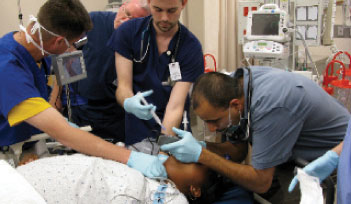
Laryngoscopy can be performed either directly (i.e. the way you’re used to doing it) or indirectly by looking at the screen. The Storz CMAC is a direct competitor to the GlideScope Ranger with direct laryngoscopy being one of the biggest differentiating factors. Both share great optics in a portable package, but the ability to teach or perform direct laryngoscopy is a great benefit that only the CMAC offers. The kicker with the CMAC over even the other Storz devices is the ability to record to an SD card reader built into the screen. The record button is built directly into the handle so a simple push of the button and you’re recording. This is great for teaching but I think will see even more use in EMS QI. Now there will be no question as to whether or not the tube was in the right hole in the field.
If you’ve used other Storz fiberoptic Macs the CMAC will feel no different to your hand but is significantly easier to setup. The handle takes a bit of getting used to as it is rectangular in shape and is wider than standard laryngoscope handles. It is also slightly longer which can lead to the end of the handle hitting the patient’s chest and impeding initial placement of the blade tip in the mouth. You can accommodate for this by either hyperextending the PT’s neck or canting the handle clock-wise during initial placement. Once in, the oropharynx direct airway visualization is accomplished in exactly the same fashion as any other Mac intubation except you have the added benefit of being able to look at the screen at any point or to have someone guiding you through your direct laryngoscopy. The second view on the screen offers a phenomenal teaching tool but will also bail you out of difficult airways. Inside the oropharynx is where you may notice another plus of the CMAC. The laryngoscope’s video source is heated which greatly reduces fogging issues when compared to traditional systems. Once an ETT is placed you can easily come back for a second indirect look with minimal manipulation of the patient’s oropharynx of neck offering an easy way to confirm tube placement after a patient has been transported.
Although the CMAC is a great overall device it is not perfect. While the optics are as good as comparable models, the video resolution of the recordings leaves a bit to be desired. At 320 x 240 and 30 frames/second the resolution is about 1/4 that of a standard-definition television. Lastly, while having the recording option built into the handle is great, on more than one occasion we had recordings inadvertently stopped when the intubator accidently hit the record button while recording an intubation. This could be easily remedied by requiring a second click to verify that you want to stop recording before actually stopping. Hopefully Storz will fix this with a future firmware update. These are minor complaints in what is another great product from Karl Storz.
Pros: Heated camera head, can directly visualize, built-in recording, competitive price (in relation to other fiberoptics)
Cons: Too easy to accidentally stop recording, recording resolution could be better, price still higher than non-fiberoptic airway adjuncts







1 Comment
Thank you for this article. We have the CMAC but are prohibited from recording laryngoscopy attempts because the SD card reader doesn’t meet our security standards for sensitive data. Is there a way of encrypting those recordings? Are you aware of hospital policies or processes in use that enable recording.
Thank you.